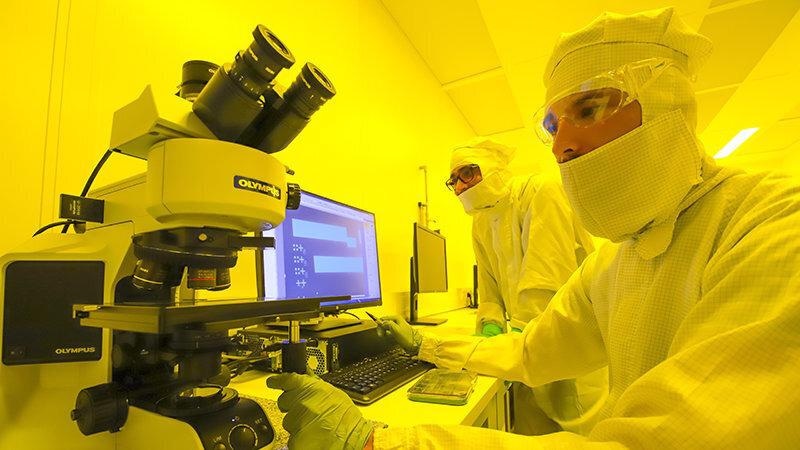Jan 21 2021
Two researchers from the Chemnitz University of Technology and Leibniz Institute for Solid State and Materials Research Dresden have presented a commentary on the topic “Tiny robots and sensors need tiny batteries – here’s how to do it” in the latest issue of the scientific journal, Nature.
 Scientists and students also find excellent conditions for interdisciplinary research and study in the field of micro- and nanotechnology at the Center for Materials, Architectures, and Integration of Nanomembranes (MAIN) at Chemnitz University of Technology. Image Credit: Image archive of the Press and Crossmedia Editorial Office/Jacob Müller.
Scientists and students also find excellent conditions for interdisciplinary research and study in the field of micro- and nanotechnology at the Center for Materials, Architectures, and Integration of Nanomembranes (MAIN) at Chemnitz University of Technology. Image Credit: Image archive of the Press and Crossmedia Editorial Office/Jacob Müller.
This commentary discusses the different types of techniques that can be currently used to produce tiny batteries for use in microelectronics, and also discusses the kind of issues that still need to be addressed, and what is actually significant.
Professor Dr Oliver G. Schmidt is one of the authors of the study. He leads the Institute for Integrative Nanoscience at the Leibniz Institute for Solid State and Materials Research Dresden and, as Professor of Materials for Nanoelectronics at the Chemnitz University of Technology, has established the Center for Materials, Architectures, and Integration of Nanomembranes (MAIN).
Dr Schmidt has also received the Leibniz Prize—the most significant research funding award in Germany.
Along with his research team, Dr Schmidt has been following the dream of “batteries in dust grains” for over a decade. For instance, the team produced ultra-thin layer systems that wind on their own into minute ultra-compact energy storage devices many times over.
As a matter of fact, the combination of layers can be selected almost randomly, making it possible to store different types of energy.
Using the magnetic origami technique, the researchers were also able to fold nanomembranes into 3D microelectronic devices and produced the smallest microelectronic robots in the world. These and other similar ways to reduce the battery size have been emphasized in the Nature article. But the article also states the problems that must be solved in the days to come.
Schmidt and Minshen Zhu, the co-author of the study from the Leibniz Institute for Solid State and Materials Research Dresden, already know that interdisciplinary teamwork will become more and more significant in the days to come.
Hence, according to them, interdisciplinary international conferences are meaningful, where they can design a standard roadmap for microbattery performance as well as target specifications.
Furthermore, interdisciplinary groups integrating the know-how from electrochemistry, microelectronics, and battery and materials sciences, amongt others, must progressively perform studies on solutions.
We are also calling on universities worldwide to train scientists with even more interdisciplinary research skills needed to build the next generation of microtechnologies.
Dr Oliver G. Schmidt, Professor and Head, Institute for Integrative Nanoscience, Leibniz Institute for Solid State and Materials Research Dresden
For instance, in Guangzhou, China, a new campus of the Hong Kong University of Science Technology—a leading research institution in the world—is presently being constructed with an investment of two billion U.S. dollars, where expertise from microelectronics ad materials science is being brought together to enhance the incorporation of nano-devices and micro-devices into multifunctional constituents, Dr Schmidt added.
The Chemnitz University of Technology is following an analogous interdisciplinary educational approach in Germany—for example, the English-language Micro and Nano Systems Master’s program integrates the know-how from electronics, photonics, electronics, energy storage, microrobotics, and biotechnology to prepare students for the intricate microsystems technology of the future.
In this way, problem solvers of tomorrow can be trained who, among other things, will also help to develop and mass-produce high-performance microbatteries.
Dr Oliver G. Schmidt, Professor and Head, Institute for Integrative Nanoscience, Leibniz Institute for Solid State and Materials Research Dresden
With their article published in the Nature journal, Schmidt and Zhu also want to raise awareness for more interdisciplinarity work at other research and educational institutions.
Journal Reference:
Schmidt, O G & Zhu, M (2021) Tiny robots and sensors need tiny batteries – here’s how to do it. Nature. doi.org/10.1038/d41586-021-00021-2.